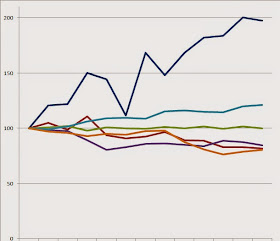Those of you who know me, know I’m a business guy at heart.
I went to school for business…twice. I really enjoy it and am passionate about
it. That’s why turning something I like outside of business into a business
suits me well. I trade on MTGO. I like it because it’s a lot easier to trade
than in paper MTG. The number of players is a lot smaller, but it’s still a
viable business opportunity.
In the more advanced business education I have received a major
theme was identifying important information. Now I know that sounds simple, but
there’s a lot to it. What’s important, sounds easy enough but in practice it’s
not always easy. Many business textbook authors describe identifying important
information as both identifying what is actually important AND identifying what’s
not important. What isn’t important is just as important as what is important
information….a lot of importance there.
One common identification of important information that I
find to be the most useful is identifying trends. Trends and how to spot them is a huge topic
and I’m going to have to split it into several different posts otherwise I’d
end up writing a 30 page paper and you’d have to read it. It’s a lot easier in
small doses.
Trends can be seen in most cards on MTGO, of course this doesn’t really apply to the bulk rares. But if we look at any blue dual land from Vintage Masters we will see a downward trend, in cards that aren’t “chase” cards like Dack Fayden, there’s an upward trend.
The part of trends I’m focusing on today are cyclical trends in Standard legal cards. Now, the trend is easy to spot, look at a line graph and see it. Simple enough, but how can we predict the trends?
The basic rule of thumb is that when a big set, like Theros is
released, it gets drafted a lot on MTGO (check out my earlier article where I
talk a little about drafts, the main point is that the majority of MTGO cards in
circulation are opened in a draft event). So generally the price goes down
until Born of the Gods comes out. Then the number of packs drafted changes from Theros, Theros, Theros to Theros, Theros, Born of the Gods. When less Theros is drafted, the price begins to climb. It
climbs until the last set of the block is released. It’s because as less new
copies of the card enter circulation, the demand stays the same and drives the
price up. So now the block is released, what happens next? The price drops.
Why does the price drop? It drops from the theory I call the
“shiny new thing” theory. There isn’t another standard Pro Tour Qualifier season for about 6
months, and cool stuff like Vintage Masters and Magic 2015 were released. I think most players
have a limited budget and have to sell many of their cards to acquire different
cards, they don’t have a lot of money to sink into the game every paycheck.
After the first set of the next block is released (Khans of Tarkir in this
case), Standard Pro Tour Qualifier season will start and things will change yet again. The
price will go up. My friend Dan, who also writes here, calls it the “do not buy
period”. This is because the supply is not increasing because not many, if
anyone, is drafting the old block when the new one comes out. Then as the card
approaches it’s end of life in Standard the price falls.
I want to go into more detail with this and this is a very rough outline of what happens but that will have to be in another article. Thanks for reading.
If there are any topics you want to hear about, go ahead and
post them in the comments and I’ll talk about them in an upcoming article.




No comments:
Post a Comment